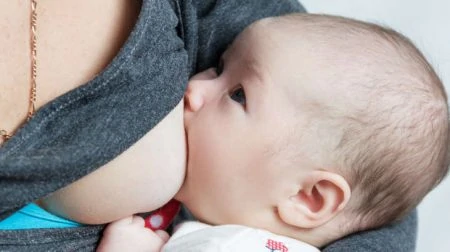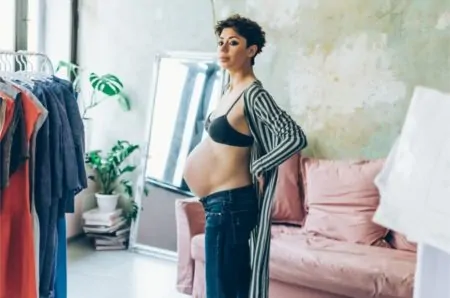Let’s be honest, finding a bra that fits is hard enough when your body isn’t changing every week. Add pregnancy hormones and a growing bust to the mix, and it can feel impossible.
We also know how awkward it is to have a stranger in a fitting room getting up close and personal with a measuring tape.
In this guide, we will break down exactly how to measure yourself at home so you can find the perfect maternity or nursing bra without the stress.
Key Takeaways
- Prioritize fit: A properly fitted bra prevents back pain, skin irritation, and even blocked milk ducts during nursing.
- Measure frequently: Your cup and band size will likely change throughout pregnancy and postpartum, so re-measure often.
- Do the math: Measure your rib cage (band) and fullest bust point (cup), then subtract the band from the bust to get your size.
- Look for features: Maternity bras offer wider straps, extra hooks, and stretchy fabric to accommodate fluctuating sizes.
Why a Good Fit Matters
Wearing an ill-fitting bra is uncomfortable at the best of times, but when you are pregnant or nursing, it can cause genuine health issues. Since your breasts are heavier and more sensitive right now, they require precise support.
Ignoring the fit can lead to several annoying or painful problems:
- Breast pain: Without proper suspension, the added weight of your breasts pulls on ligaments. This lack of support is a primary cause of soreness and pain.
- Stretch marks: Rapid growth stretches the skin (1). A supportive bra helps fight gravity and may reduce unnecessary skin stretching that leads to permanent marks.
- Back and neck strain: If the band isn’t doing the heavy lifting, your shoulders take the brunt of the weight. This often results in tension headaches and severe back pain.
- Poor posture: To compensate for the heavy front load, you might naturally hunch forward. A good bra lifts the chest, encouraging you to stand taller.
- Skin irritation: Chafing under the breast or on the shoulders can lead to rashes. This is especially common if you are overheating, which happens often during pregnancy.
Beyond comfort, tight bras can actually compress breast tissue, potentially leading to clogged ducts or mastitis once your milk comes in. Research has also linked chronic ill-fitting bras to a higher desire for breast reduction surgery later in life (2).
When to Buy a Maternity Bra
Timing is everything. If you buy too early, you might outgrow the bra in a month. If you wait too long, you’ll be uncomfortable.
Here is a general timeline for shopping:
- First Trimester: You may not need a “maternity” bra yet, but you might need a larger cup size as tenderness sets in. Look for seamless, stretchy styles.
- Second Trimester: Your rib cage may expand as the baby grows. This is a great time to buy a bra with extra hooks or buy adjustable maternity bras.
- Third Trimester (Week 36+): This is the ideal time to buy nursing bras. Your breasts are close to the size they will be when your milk regulates, though you should leave a little room for engorgement.
How to Measure Your Bra Size at Home
You don’t need a professional to get the right number. Grab a soft measuring tape and follow these steps.
- Measure the band: Wrap the tape measure around your rib cage, directly under your bust where the bra band sits. Keep the tape snug and level. Round to the nearest whole number. If it’s an odd number, round up to the next even number. This is your band size (e.g., 34, 36, 38).
- Measure the cup: Wrap the tape around the fullest part of your breasts (usually across the nipple). Keep the tape straight across your back. It should be touching your skin but not squeezing or indenting the breast tissue. Round this to the nearest whole number.
- Do the math: Subtract your band size (Step 1) from your bust measurement (Step 2). The difference in inches tells you your cup size.
Here is a quick cheat sheet for the difference in inches:
- 0-1 inch: A Cup
- 2 inches: B Cup
- 3 inches: C Cup
- 4 inches: D Cup
- 5 inches: DD/E Cup
- 6 inches: DDD/F Cup
How to Check the Fit by Style
Numbers are a great starting point, but every brand fits differently. The real test is how it feels when you put it on.
Everyday Cupped Bras
Whether it is wired or wireless, run through this checklist when trying on a new bra:
- The Band: This provides 80% of the support. It should be parallel to the floor and not ride up your back. You should be able to slide two fingers comfortably under the band, but no more.
- The Straps: These should not dig into your shoulders. If they are leaving deep red grooves, the band is likely too loose, forcing the straps to carry too much weight. They should be snug but liftable.
- The Cups: Your breast tissue should be fully contained. If you have “quad-boob” (spilling over the top) or side spillage, size up. If the fabric is wrinkling or gaping, size down.
- The Center Gore: This is the piece of fabric between the cups. In a wired bra, it should sit flat against your sternum. In a wireless maternity bra, it might not sit perfectly flat, but it should stay close to the chest.
- The Underwire: If you choose a wired bra, the wire must circle the breast tissue, not sit on it. Pressing on the tissue can cause blocked ducts during breastfeeding.
Sports Bras
Staying active is great for you and the baby, but you need to minimize bounce to protect your ligaments. Maternity sports bras generally fall into three categories: compression (squishes them down), encapsulation (separates them), or a combo of both.
Use this checklist to ensure you are safe to exercise:
- Band test: Just like a regular bra, the band should be firm. Raise your arms over your head; if the band moves up your ribcage, it is too loose.
- Bounce test: Jump up and down (carefully!). A good sports bra should significantly reduce movement. If you feel pain or excessive bouncing, you need a more supportive style, like a combination bra.
- Strap width: Look for wide, padded straps. Thin spaghetti straps rarely offer enough support for high-impact activities during pregnancy.
- Room to breathe: While it should be tight, you must be able to take a deep breath. Pregnancy already shortens your breath; don’t let your bra make it harder.
Maternity vs. Nursing vs. Regular Bras
You might be tempted to just buy a regular bra in a bigger size. While that works in a pinch, specific maternity and nursing bras are engineered for your changing reality (3).
Regular Bras
These are designed for stable breast sizes. They often have rigid underwires and limited hook settings (usually only three rows). They lack the stretch and recovery fabric needed for daily fluctuations in milk supply or pregnancy weight gain.
Maternity Bras
These are built for comfort during pregnancy. They typically feature:
- Softer linings: To accommodate sensitive nipples.
- No underwire: Or flexible “flexi-wire” to prevent digging into the growing belly.
- Extra hooks: Many come with 4-6 rows of hooks in the back to accommodate rib cage expansion.
- Wider bands: To help support the extra weight without digging in.
Nursing Bras
These have all the comfort features of maternity bras but add functionality for feeding.
- Nursing clips: Located at the top of the cup, these allow you to drop the cup down with one hand while holding a hungry baby.
- Inner slings: A strip of fabric that keeps the bra strap in place while the cup is dropped, providing support even while you feed.
- Flexibility: The cups are often stretchy to handle the size difference between “just fed” and “engorged.”










